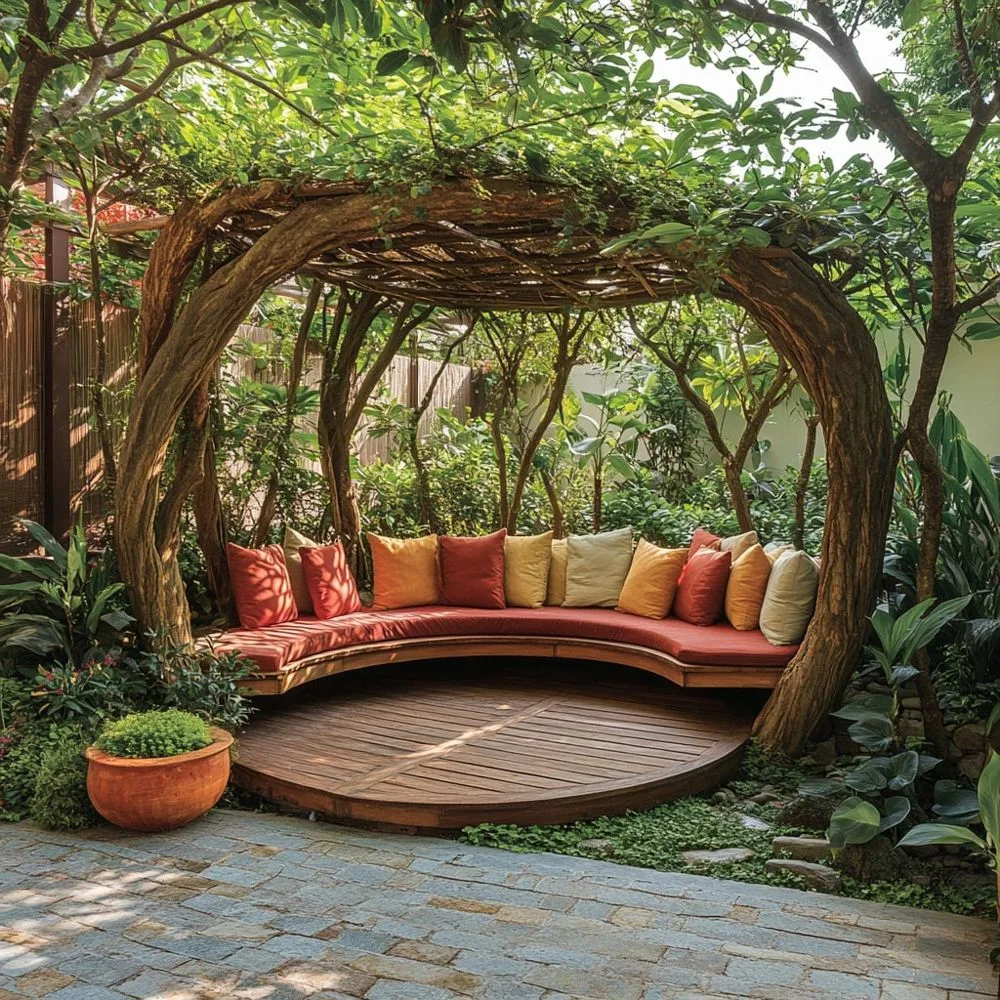Imagine sipping coffee under a shaded canopy, surrounded by the rustling leaves of a majestic tree in your backyard. Tree gazebos make this vision a reality, blending architectural elegance with the beauty of nature. These unique structures are built around or incorporate existing trees, creating a seamless connection between your outdoor space and the environment. Whether you’re seeking a cozy retreat, a stunning garden centerpiece, or a functional entertaining area, tree gazebos offer endless possibilities. In this expanded guide, we’ll dive deep into the world of tree gazebos, covering their benefits, types, design ideas, installation, maintenance, costs, and more to help you create the perfect outdoor oasis.
What Are Tree Gazebos?
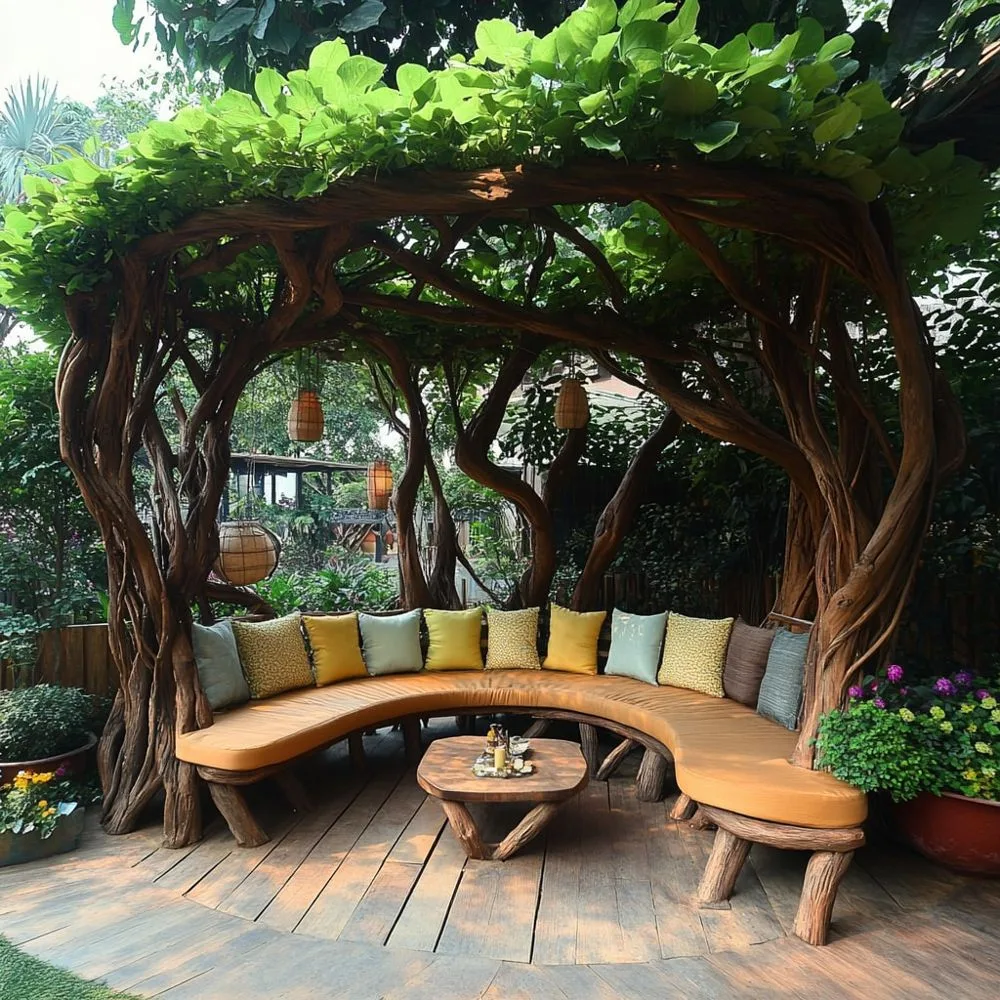
Tree gazebos are outdoor structures designed to integrate with one or more trees, using them as natural supports, focal points, or aesthetic elements. Unlike traditional gazebos, which stand independently, tree gazebos harmonize with the landscape by embracing the tree’s trunk, branches, or canopy. They can be crafted from materials like wood, metal, or composite and are available in various styles, from rustic to modern, to suit any backyard aesthetic.
Why Choose a Tree Gazebo?
Tree gazebos stand out for their unique blend of functionality and natural beauty. Here’s why they’re a fantastic choice:
- Seamless Nature Integration: By incorporating trees, these gazebos enhance your yard’s natural charm while preserving its ecosystem.
- Sustainable Design: Building around trees minimizes environmental impact, making tree gazebos an eco-friendly option.
- Distinctive Aesthetic: The fusion of man-made structures and living trees creates a visually captivating focal point.
- Natural Shade and Comfort: Trees provide cooling shade, making tree gazebos ideal for relaxing during warm weather.
- Customizable Appeal: With endless design options, tree gazebos can be tailored to match your style and needs.
Benefits of Installing a Tree Gazebo
Tree gazebos offer a range of advantages that elevate your outdoor living experience. Let’s explore these benefits in detail:
Enhanced Outdoor Living Space
A tree gazebo creates a dedicated area for relaxation, dining, or socializing. It’s perfect for hosting summer barbecues, reading quietly, or enjoying family gatherings in a shaded, comfortable setting.
Increased Property Value
A well-crafted tree gazebo can boost your home’s curb appeal and market value. Potential buyers often view unique, nature-integrated features like tree gazebos as premium additions that set your property apart.
Deep Connection with Nature
By incorporating a living tree, these gazebos immerse you in nature. The sound of leaves, the sight of greenery, and the fresh air create a tranquil atmosphere ideal for mindfulness and relaxation.
Versatile Functionality
Tree gazebos can serve multiple purposes, from a romantic dinner spot to a yoga retreat or a children’s play area. Their versatility makes them a valuable addition to any backyard.
Eco-Friendly Appeal
By preserving trees and minimizing land disruption, tree gazebos align with sustainable living practices, appealing to environmentally conscious homeowners.
Types of Tree Gazebos

Tree gazebos come in various styles and materials, each offering distinct advantages. Here are the most popular types:
Wooden Tree Gazebos
Wooden gazebos exude timeless charm and blend effortlessly with natural surroundings. Common materials include cedar, redwood, and pressure-treated pine, known for their durability and weather resistance.
Benefits of Wooden Gazebos
- Warm, rustic aesthetic that complements any landscape.
- Customizable with stains or paints to match your decor.
- Sustainable when sourced from responsibly managed forests.
Considerations
- Requires regular maintenance to prevent rot or insect damage.
- May be more expensive depending on wood quality.
Metal Tree Gazebos
Metal gazebos, typically made from aluminum or steel, offer a sleek, modern look with minimal upkeep. They’re ideal for homeowners seeking durability and a contemporary vibe.
Benefits of Metal Gazebos
- Resistant to rust and weathering with proper coatings.
- Lightweight yet strong, ensuring long-term stability.
- Low maintenance compared to wood.
Considerations
- May lack the warmth of wooden designs.
- Can be costlier for high-end finishes.
Pergola-Style Tree Gazebos
Pergola-style gazebos feature an open lattice roof, allowing sunlight to filter through while providing partial shade. They’re perfect for showcasing climbing plants or vines alongside the tree.
Benefits of Pergola-Style Gazebos
- Encourages natural growth of vines, roses, or ivy for a lush look.
- Creates a romantic, garden-inspired ambiance.
- Flexible design accommodates various tree sizes and shapes.
Considerations
- Offers less protection from rain due to open roof.
- May require additional support for heavy plant growth.
Hybrid Tree Gazebos
Hybrid gazebos combine materials, such as wood and metal, to create a unique look. For example, a wooden frame with metal accents can offer both warmth and modernity.
Benefits of Hybrid Gazebos
- Combines the best features of multiple materials.
- Highly customizable for a bespoke appearance.
- Balances durability and aesthetic appeal.
Considerations
- Can be more complex and costly to build.
- Maintenance varies by material used.
How to Choose the Perfect Tree Gazebo
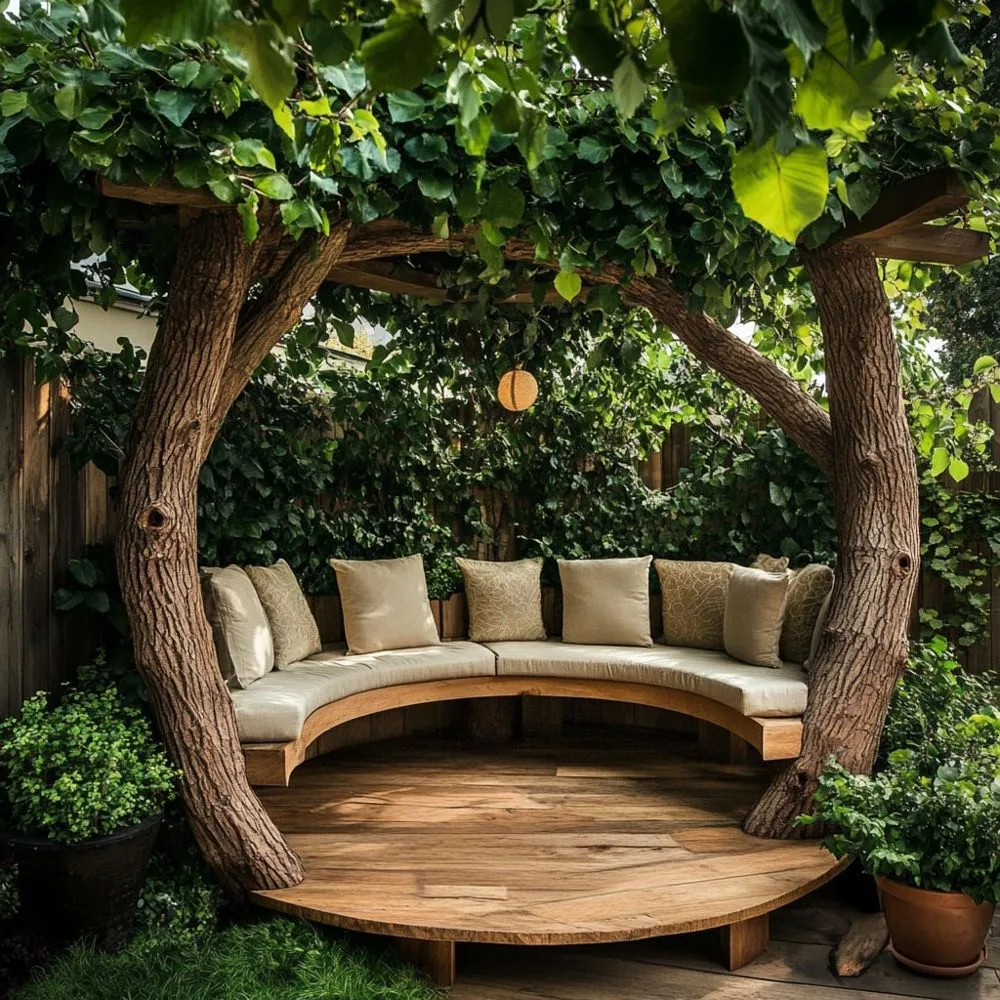
Selecting the right tree gazebo involves balancing aesthetics, functionality, and practicality. Follow these steps to make an informed decision:
Evaluate Your Tree’s Health
Consult an arborist to assess the tree’s health and structural integrity. A healthy tree with a strong trunk and root system is essential for a safe and lasting gazebo.
Define the Gazebo’s Purpose
Consider how you’ll use the gazebo. Will it be a social hub, a quiet retreat, or a decorative garden feature? This will influence its size, design, and features.
Set a Realistic Budget
Tree gazebos range in price from a few hundred to several thousand dollars, depending on materials, size, and labor. Establish a budget to guide your choices.
Match Your Home’s Aesthetic
Choose a gazebo style that complements your home’s architecture. A modern metal gazebo suits contemporary homes, while a wooden pergola fits rustic or traditional settings.
Plan for Long-Term Maintenance
Consider the upkeep required for your chosen material. Wooden gazebos need periodic sealing, while metal ones require occasional cleaning and rust checks.
Check Local Regulations
Verify local building codes and zoning laws. Some areas require permits for permanent structures, especially those attached to trees.
Designing a Tree Gazebo: Creative Ideas
A well-designed tree gazebo can become the centerpiece of your backyard. Here are some creative ideas to inspire your project:
Incorporate Natural Elements
Surround the gazebo with potted plants, flower beds, or stone pathways to enhance its natural appeal. Consider adding a small water feature, like a fountain, for a soothing ambiance.
Add Comfortable Seating
Install built-in benches or place weather-resistant furniture, such as wicker or teak, inside the gazebo. Add cushions, throw pillows, or blankets in vibrant colors for a cozy feel.
Enhance with Lighting
Use string lights, lanterns, or solar-powered LEDs to make the gazebo usable at night. Wrap lights around the tree trunk or hang them from the roof for a magical glow.
Customize with Accessories
Add curtains, privacy screens, or outdoor rugs to personalize the space. Sheer curtains can provide shade and elegance, while rugs add warmth underfoot.
Create a Themed Gazebo
Design the gazebo around a theme, such as a tropical oasis with bamboo accents or a rustic retreat with log furniture. Themes add personality and make the space memorable.
Integrate Technology
For a modern touch, consider adding weatherproof speakers, Wi-Fi extenders, or smart lighting. These features enhance functionality for entertaining or remote work.
Installation Tips for Tree Gazebos
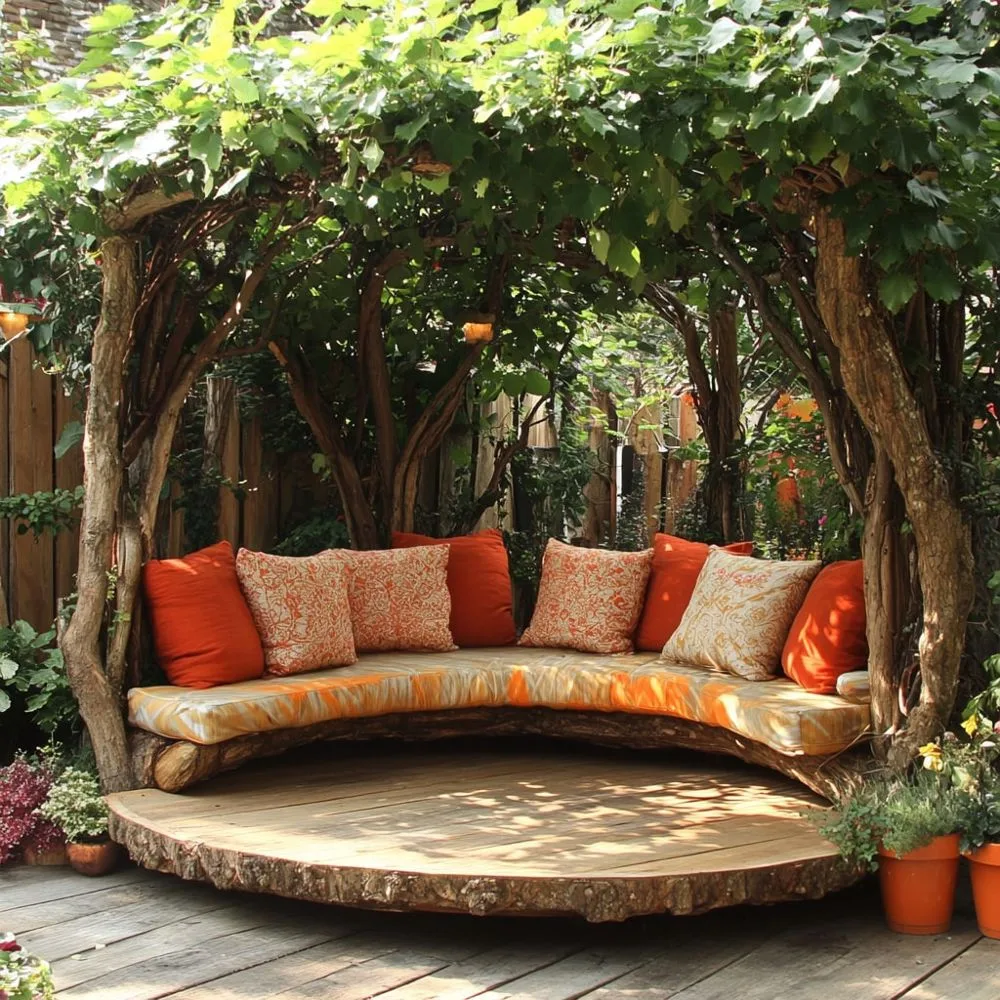
Proper installation ensures your tree gazebo is safe, durable, and harmonious with the tree. Follow these expert tips:
Hire Experienced Professionals
Work with contractors or gazebo builders experienced in tree-integrated designs. They’ll know how to construct the structure without harming the tree or violating codes.
Protect the Tree’s Roots
Avoid compacting the soil around the tree’s root zone during construction. Use permeable materials like gravel, pavers, or elevated decking to allow water and air to reach the roots.
Accommodate Tree Growth
Design the gazebo with clearance for the tree’s future growth. Flexible supports, adjustable beams, or open designs prevent damage as the tree expands.
Secure the Structure
Anchor the gazebo securely to withstand wind, rain, and other weather conditions. Use corrosion-resistant fasteners for metal gazebos and sturdy bolts for wooden ones.
Minimize Tree Stress
Avoid attaching the gazebo directly to the tree with nails or screws, as this can cause long-term damage. Instead, use floating supports or beams that rest near the tree.
Plan for Drainage
Ensure proper drainage around the gazebo to prevent water pooling, which can harm the tree’s roots or destabilize the structure.
Maintaining Your Tree Gazebo
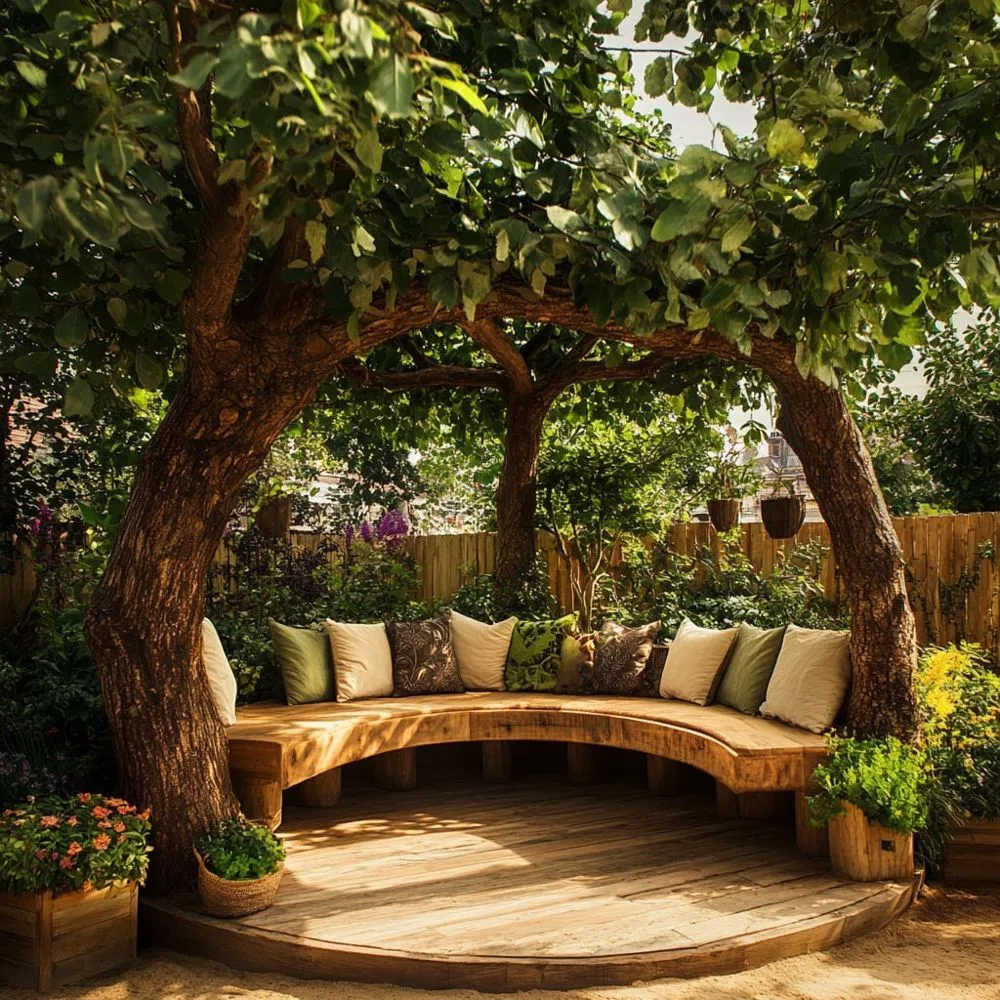
Regular maintenance keeps your tree gazebo looking pristine and ensures its longevity. Here’s how to care for different types:
For Wooden Gazebos
- Clean annually with mild soap and water to remove dirt, mildew, or algae.
- Apply a weatherproof sealant or stain every 1-2 years to protect against moisture and UV damage.
- Inspect for rot, cracks, or insect damage and repair promptly.
For Metal Gazebos
- Wipe down surfaces regularly to prevent dust or debris buildup.
- Check for rust and apply touch-up paint or anti-rust coatings as needed.
- Tighten bolts, screws, and joints to maintain structural integrity.
For Pergola-Style Gazebos
- Prune vines or climbing plants to prevent overgrowth or roof damage.
- Clean the lattice roof to remove leaves, twigs, or debris.
- Inspect wooden or metal components for wear and treat accordingly.
General Maintenance Tips
- Trim nearby branches to prevent rubbing or damage to the gazebo.
- Monitor the tree’s health with regular arborist checkups to ensure it remains stable.
- Remove snow or heavy debris from the roof to avoid structural strain.
Cost of Tree Gazebos
The cost of a tree gazebo varies based on several factors, including materials, size, design complexity, and labor. Here’s a breakdown:
Material Costs
- Wooden Gazebos: $500–$5,000, depending on wood type (e.g., pine vs. cedar) and size.
- Metal Gazebos: $800–$4,000, with aluminum being more affordable than steel.
- Pergola-Style Gazebos: $300–$3,000, depending on materials and roof design.
- Hybrid Gazebos: $1,000–$6,000, due to combined materials and custom work.
Labor Costs
- Professional installation typically ranges from $500 to $2,500, depending on complexity and location.
- Arborist consultations for tree health assessments cost $100–$300.
Additional Costs
- Accessories like lighting, furniture, or curtains: $100–$1,000.
- Permits or inspections (if required): $50–$200.
- Landscaping around the gazebo: $200–$2,000.
Total Estimated Cost
- Basic Tree Gazebo: $800–$3,000 (DIY or simple design).
- Mid-Range Tree Gazebo: $2,000–$7,000 (professional installation, quality materials).
- High-End Tree Gazebo: $7,000–$15,000 (custom design, premium materials, extensive landscaping).
To save costs, consider DIY kits for simpler designs or repurpose existing materials, but ensure professional oversight for tree safety.
Adapting Tree Gazebos to Different Climates
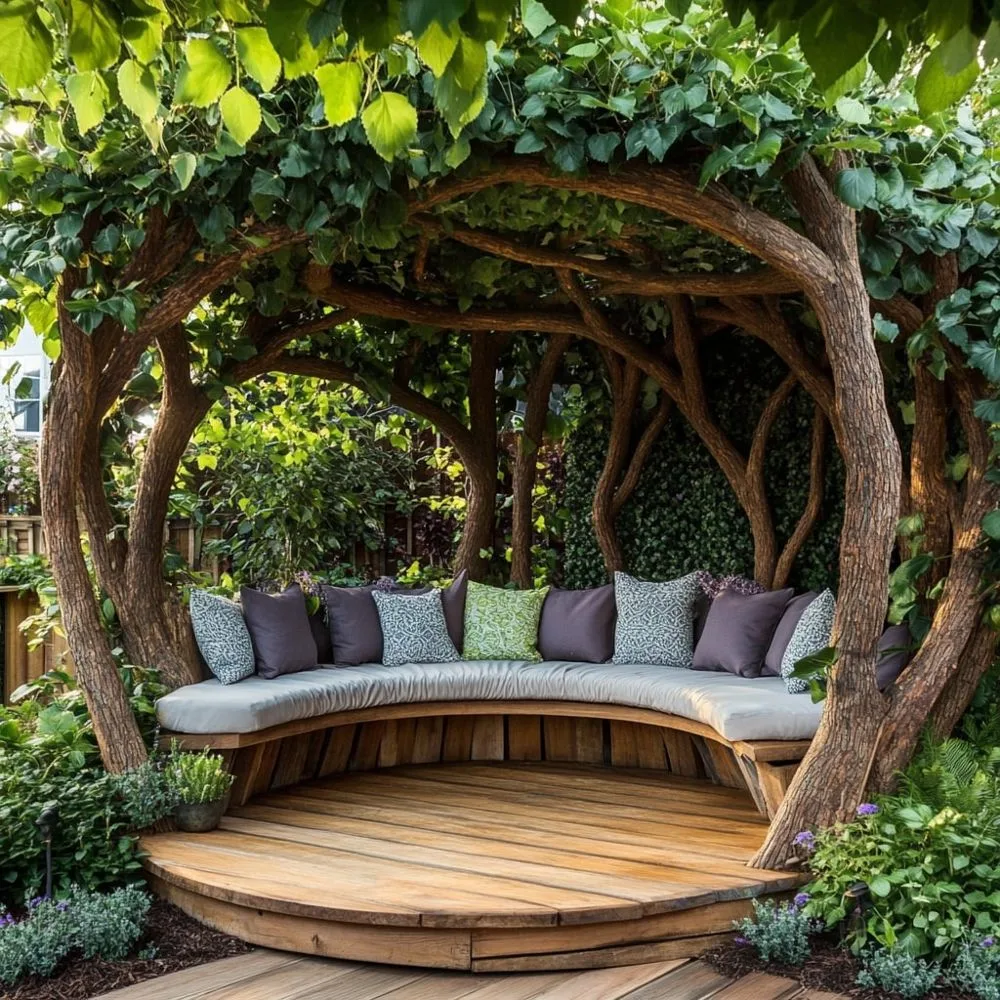
Tree gazebos can thrive in various climates with the right adaptations:
Hot and Sunny Climates
- Use UV-resistant materials like treated wood or powder-coated metal.
- Add retractable awnings or shade sails for extra sun protection.
- Incorporate drought-tolerant plants around the gazebo.
Cold and Snowy Climates
- Choose sturdy materials like steel or pressure-treated wood to withstand snow loads.
- Design a sloped roof to prevent snow accumulation.
- Insulate furniture or store it indoors during winter.
Humid or Rainy Climates
- Apply waterproof sealants to wooden gazebos to prevent mold.
- Use rust-resistant metals like aluminum or galvanized steel.
- Ensure proper drainage around the gazebo to protect the tree’s roots.
Windy Climates
- Secure the gazebo with deep anchors or reinforced footings.
- Opt for open designs like pergolas to reduce wind resistance.
- Avoid heavy decorations that could become wind hazards.
Common Mistakes to Avoid with Tree Gazebos
Avoid these pitfalls to ensure your tree gazebo is safe and long-lasting:
- Neglecting Tree Health: Building around a weak or diseased tree can lead to collapse or safety risks.
- Poor Design Planning: Failing to account for tree growth or root systems can damage both the tree and gazebo.
- Overloading the Structure: Heavy furniture, decorations, or climbing plants can strain the gazebo or tree.
- Ignoring Permits: Check local regulations to avoid fines or forced removal.
- Skipping Maintenance: Neglecting upkeep can lead to rot, rust, or structural failure.
- DIY Without Expertise: Complex designs require professional skills to protect the tree and ensure stability.
Global Inspirations: Tree Gazebos Around the World

Tree gazebos draw inspiration from various cultures and landscapes. Here are some examples:
Japanese Zen Gazebos
- Feature minimalist wooden designs with low roofs, often built around cherry or maple trees.
- Emphasize tranquility with stone paths and water features.
- Ideal for meditation or tea ceremonies.
Mediterranean Pergola Gazebos
- Use whitewashed wood or wrought iron with grapevines or bougainvillea.
- Built around olive or citrus trees for a sunny, coastal vibe.
- Perfect for outdoor dining or entertaining.
Tropical Tree Gazebos
- Incorporate bamboo or teak with thatched roofs, built around palm or banyan trees.
- Feature vibrant fabrics and open designs for airflow.
- Suited for warm, humid climates.
Scandinavian Forest Gazebos
- Use raw, untreated wood with simple, functional designs around pine or birch trees.
- Include fire pits or cozy textiles for year-round use.
- Blend seamlessly with forested landscapes.
These global styles can inspire your tree gazebo, adding cultural flair to your backyard.
Transform Your Backyard with a Tree Gazebo
Tree gazebos are a captivating blend of nature and craftsmanship, offering a unique way to elevate your outdoor space. By integrating a living tree into a beautifully designed structure, you create a serene, functional, and eco-friendly retreat that enhances your lifestyle and property value. Whether you choose a rustic wooden gazebo, a sleek metal design, or a lush pergola-style structure, the possibilities are endless.
With thoughtful planning, professional installation, and regular maintenance, your tree gazebo can become a cherished part of your home for decades. Consider your budget, climate, and design preferences, and draw inspiration from global styles to craft a space that reflects your personality. Start exploring tree gazebo ideas today and turn your backyard into a nature-inspired haven that you’ll love for years to come!

